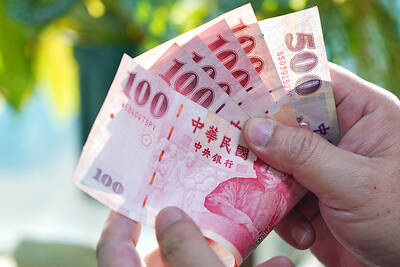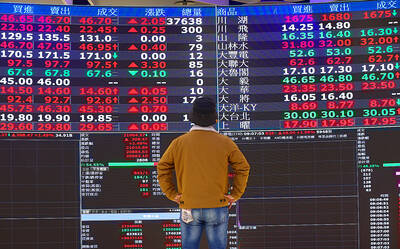US President Donald Trump’s tariffs are helping to erode China’s appeal as a place where stuff gets made.
Ricoh Co is moving some manufacturing from China to Thailand to avoid potential risks from US-China trade tensions, the Japanese office-equipment maker said on Thursday.
The announcement came hours after a report that Taiwan’s Kenda Rubber Industrial Co (建大輪胎) is investing in Vietnam to do the same.
Those two examples are just the most recent from a chorus of executives who are citing the trade dispute as the final straw in their shift out of China, with margins already squeezed by rising labor costs, tougher environmental standards and domestic competition.
“The purpose is to minimize the impact of tariff increases,” Ricoh said in a statement, referring to the newly announced US tariffs on the rest of imports from China.
The firm is to produce all US-bound multifunction printers in Thailand instead of Shenzhen.
It said it would consider various changes to its production structure, including moving more production to Thailand from China, to “respond to various risks and improve efficiency.”
Big consumer brands Samsonite International SA, Macy’s Inc and Fossil Group Inc have all said that they are continuing to move production and sourcing out of China.
“We’re generally under an initiative to kind of shift what we can from China, which we were doing even ahead of tariffs,” Samsonite CEO Kyle Gendreau said on a call on Tuesday. “And we’re just continuing to accelerate on the mix of what’s coming from China to kind of mitigate the impacts there as well.”
The threatened tariffs of 25 percent on all exports to the US, which accounts for one-fifth of China’s total outbound shipments, are set to give China the stiffest test of its role as the core of the global supply chain.
For Cisco Systems Inc, shipping from other nations is the way to go.
“We still have some manufacturing happening in China, but we have greatly, greatly reduced our exposure working with our supply chain and our suppliers,” chief financial officer Kelly Kramer said on a call with analysts on Wednesday when asked about the impact of the tariffs. “So the impact that we’re expecting, again we are trying to mitigate.”
Retailing giant Walmart Inc, whose clout with suppliers gives it some room to maneuver, indicated that shoppers would absorb some of the costs of higher levies.
“We will do everything we can to keep prices low, but increased tariffs lead to increased prices,” chief financial officer Brett Biggs said in an interview on Thursday.
Finding alternative manufacturers “is one of a number of actions that our merchants are considering,” he added.
Some businesses have already moved following last year’s tariffs on the first batch of Chinese products.
Communication equipment producer Sierra Wireless Inc has almost completed moving some production to Vietnam, reducing the firm’s exposure to further trade flaring, chief financial officer David McLennan said on May 9.
While Chinese exporters reel at the escalating tensions, other nations and businesses are extending invitations to those driven out of China.
If the trade dispute between the US and China continues, it opens “a door for South America to occupy this space,” Fernando Queiroz, CEO of the Sao Paulo-based meat producer Minerva SA, said on Wednesday.

The US dollar was trading at NT$29.7 at 10am today on the Taipei Foreign Exchange, as the New Taiwan dollar gained NT$1.364 from the previous close last week. The NT dollar continued to rise today, after surging 3.07 percent on Friday. After opening at NT$30.91, the NT dollar gained more than NT$1 in just 15 minutes, briefly passing the NT$30 mark. Before the US Department of the Treasury's semi-annual currency report came out, expectations that the NT dollar would keep rising were already building. The NT dollar on Friday closed at NT$31.064, up by NT$0.953 — a 3.07 percent single-day gain. Today,

‘SHORT TERM’: The local currency would likely remain strong in the near term, driven by anticipated US trade pressure, capital inflows and expectations of a US Fed rate cut The US dollar is expected to fall below NT$30 in the near term, as traders anticipate increased pressure from Washington for Taiwan to allow the New Taiwan dollar to appreciate, Cathay United Bank (國泰世華銀行) chief economist Lin Chi-chao (林啟超) said. Following a sharp drop in the greenback against the NT dollar on Friday, Lin told the Central News Agency that the local currency is likely to remain strong in the short term, driven in part by market psychology surrounding anticipated US policy pressure. On Friday, the US dollar fell NT$0.953, or 3.07 percent, closing at NT$31.064 — its lowest level since Jan.

The New Taiwan dollar and Taiwanese stocks surged on signs that trade tensions between the world’s top two economies might start easing and as US tech earnings boosted the outlook of the nation’s semiconductor exports. The NT dollar strengthened as much as 3.8 percent versus the US dollar to 30.815, the biggest intraday gain since January 2011, closing at NT$31.064. The benchmark TAIEX jumped 2.73 percent to outperform the region’s equity gauges. Outlook for global trade improved after China said it is assessing possible trade talks with the US, providing a boost for the nation’s currency and shares. As the NT dollar

The Financial Supervisory Commission (FSC) yesterday met with some of the nation’s largest insurance companies as a skyrocketing New Taiwan dollar piles pressure on their hundreds of billions of dollars in US bond investments. The commission has asked some life insurance firms, among the biggest Asian holders of US debt, to discuss how the rapidly strengthening NT dollar has impacted their operations, people familiar with the matter said. The meeting took place as the NT dollar jumped as much as 5 percent yesterday, its biggest intraday gain in more than three decades. The local currency surged as exporters rushed to